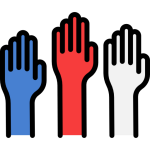
Supplemental Nutrition in Jeopardy: Key Facts About CalFresh Beneficiaries
SNAP and CalFresh Overview
The Supplemental Nutrition Assistance Program (SNAP) is the nation’s largest food assistance program addressing food insecurity among low-income individuals and families. The program is funded entirely by the federal government, while states are responsible for administering benefits and sharing in the operational costs.1 To qualify for SNAP benefits, individuals generally must have a household income below 200% of the federal poverty level (FPL).2 Only U.S. citizens and certain lawfully present noncitizens may receive SNAP benefits,3 and monthly benefits vary based on factors such as household size, income, disability benefits, and living expenses.4
SNAP, known as CalFresh in California, is a critical lifeline for qualifying state residents. In 2023, nearly 45% of adults in California struggled to afford food.5 Between 2023 and 2024, California administered a total of $12 billion in CalFresh benefits to 5 million individuals.6 During this time, the monthly benefits averaged $189 per recipient.7 To put this in perspective, the average monthly cost of groceries for a typical California family with children was more than $1,200.8
Federal Proposals Threaten Food Security for Millions in California
The latest Senate reconciliation bill is estimated to reduce federal SNAP spending by $186 billion through 2034.9 Key provisions include instituting work requirements for able-bodied working-age adults, even those who are parents or caretakers of young children; stripping out current exemptions for vulnerable populations including veterans, people experiencing homelessness, and young people who have aged out of foster care; and shifting significant SNAP costs to states based on payment error rates.10
The Congressional Budget Office estimates that more than 2 million individuals nationally would be cut from SNAP under the work requirement provision, and more than 5 million individuals live in households that would be at risk of losing at least some of their food assistance under the proposal.11
A reduction in federal funding could force states, like California, to reduce already low benefits or restrict eligibility, disproportionately harming children, seniors, veterans, and individuals with a disability,12 despite the proven role of SNAP in improving health and economic outcomes and stabilizing vulnerable communities.13 In the backdrop of upcoming simultaneous and steep cuts to Medi-Cal and SNAP, it’s important to note that these cuts compromise the strength of the broader safety net.14 Almost all (92%) of CalFresh enrollees also receive health coverage through Medi-Cal, and more than a third (34%) Medi-Cal enrollees also receive CalFresh.15
This data brief highlights key facts about CalFresh enrollees and examines the broader health implications of reducing funding to SNAP. The analysis draws on data from UCLA LPPI’s Latino Data Hub (LDH), which incorporates data from the Census Bureau’s American Community Survey (ACS). We also present data from the California Health Interview Survey (CHIS) to provide additional insights.
Key Findings
1. Nearly half of low-income Latino adults in California face food insecurity.
Close to half (48%) of Latino low-income adults (ages 18 and older) in California (Figure 1) face food insecurity and struggle to get sufficient food to meet basic needs, compared to 38% and 37% of low-income white and Asian or Pacific Islander (AAPI) adults, respectively. Food insecurity is associated with poor health and a reduced ability to access and afford health care.16 However, research shows that these negative associations are mitigated among adults participating in federal assistance programs like SNAP and Medicaid,17 underscoring the importance of CalFresh in providing necessary benefits for at-risk Californians.
Figure 1: Food Insecurity by Race and Ethnicity Among Low-Income Adults (18+) in California, 2023
Notes: This question was only asked of adults ages 18 and older whose income is less than 200% of the Federal Poverty Level. Non-Latino groups only include non-Hispanic individuals.
Source: LPPI analysis of AskCHIS, California Health Interview Survey, 2023, Food security (ability to afford enough food) [California].
2. CalFresh is essential for Latino communities.
Latinos account for more than half (55%) of all CalFresh participants (Figure 2), 25 percentage points greater than the share of white participants (20%), the second-largest racial group enrolled in the program. These disparities reflect the program’s important role in addressing food insecurity among California’s Latino communities.
Figure 2: CalFresh Enrollment by Race and Ethnicity, 2023
Notes: Data reflect the number of individuals in a household receiving CalFresh benefits. Non-Latino groups only include non-Hispanic individuals.
Source: UCLA LPPI’s Latino Data Hub.
3. CalFresh supports working families.
Among working-age (18-64) Latino CalFresh enrollees, more than two-thirds (69%) participate in the labor force (see Figure 3). Individuals in the labor force include those employed or actively job hunting. Relative to other racial and ethnic groups, Latino enrollees have the highest rate of labor force participation, followed by AAPI enrollees at 68%. This finding dispels myths that CalFresh serves primarily unemployed individuals and emphasizes the program’s vital role in supporting working-class families to meet basic food needs.
Figure 3: Labor Force Participation Rates among Working-Age (18-64) CalFresh Participants by Race and Ethnicity, 2023
Notes: The data reflect the number of civilian working-age (18-64 years) individuals in households receiving CalFresh. Non-Latino groups only include non-Hispanic individuals.
Source: UCLA LPPI’s Latino Data Hub.
4. CalFresh reaches the youngest Latinos.
Consistent with the younger demographics of the Latino population, children (0-17) make up 40% of Latino CalFresh enrollees—7 percentage points higher than the statewide average (33%) and nearly 20 points higher than the share of white enrollees (20%; see Figure 4). See Table 3 in the appendix for the additional age breakdowns of individuals receiving CalFresh.
5. CalFresh strengthens California’s broader safety net.
More than 3 million Californians, including 1.8 million Latinos (see Figure 5), are dually enrolled in CalFresh and Medi-Cal. CalFresh strengthens stable access to basic nutrition and reduces financial strain for families already facing barriers to health care and economic stability. High rates of dual enrollment demonstrate the role CalFresh has in supporting the safety net, ensuring that families facing racial disparities have access to basic needs.
Figure 5: CalFresh and Medi-Cal Dual Enrollment by Race and Ethnicity, 2023
Note: Data for CalFresh enrollees reflect the number of individuals in households receiving CalFresh. Non-Latino groups only include non-Hispanic individuals.
Source: UCLA LPPI’s Latino Data Hub.
6. Anti-immigrant policies have a chilling effect on the usage of government benefits, especially among Latino communities.
While the modifications to the “public charge” rule during the first Trump administration that would have included Medi-Cal and CalFresh enrollment as reasons to deny permanent residence status to legal permanent residents were reversed by the Biden administration,18 its chilling effect persists due to lingering mistrust and misinformation, especially among immigrant and mixed-status households.19 In 2023, 38% of Latino CalFresh enrollees and 33% of non-enrolled Latinos reported avoiding government benefits due to concerns that doing so could harm their or a family member’s immigration status (see Figure 6). These rates are significantly higher than among white (7%), Black (6%), and Asian (21%) enrollees. More publicized immigration enforcement actions, combined with efforts to link several governmental databases – including SNAP and Medicaid enrollee information – for immigration enforcement purposes,20 will further exacerbate food insecurity, hunger, and hardship among California’s most marginalized communities.
Figure 6: Avoidance of Government Benefits Due to Immigration Concerns Among CalFresh Enrollees by Race and Ethnicity, 2023
Note: Data for “Multiracial” individuals enrolled in CalFresh are unavailable due to small sample sizes.
Source: LPPI analysis of AskCHIS, California Health Interview Survey, 2023, Ever avoided government benefits due to concern over self or family member disqualification from green card/citizenship (California).
7. Cuts to CalFresh would hit California’s Latino heartland the hardest.
The following maps show the Latino share of CalFresh enrollees by county and congressional district (see Figures 7 and 8). Areas like the Central Valley and Imperial County have high Latino enrollment in CalFresh, including agricultural districts that fuel California’s economy. Cuts would directly harm working-class communities in politically influential regions. In Central Valley counties like Fresno, Tulare, and Kings, Latino residents make up about three-fourths of all CalFresh enrollees, highlighting the program’s importance to these communities. This overlaps with agricultural districts, CA-21 and CA-22, which along with the rest of California, produce over a third of all vegetables and over three-quarters of fruits and nuts for the entire country.21 Imperial County has the highest Latino enrollment share, at around 90%.
Figure 7: Latino Share of CalFresh Enrollees by County, 2023
Source: LPPI analysis of data from the Census Bureau’s American Community Survey 2023 5-year Estimates. The congressional district allocation is generated using the Geocorr 2022 from Census blocks to Public Use Microdata areas (PUMA) and Census blocks to the 119th Congressional Districts from the Missouri Census Data Center while controlling for the number of Latino/non-Latinos by congressional districts based on Census Bureau estimates.
Figure 8: Latino Share of CalFresh Enrollees by Congressional District, 2023
Source: LPPI analysis of data from the Census Bureau’s American Community Survey 2023 5-year Estimates. The congressional district allocation is generated using the Geocorr 2022 from Census blocks to Public Use Microdata areas (PUMA) and Census blocks to the 119th Congressional Districts from the Missouri Census Data Center while controlling for the number of Latino/non-Latinos by congressional districts based on Census Bureau estimates.
Appendix
Table 1. Share of Adults (18-64) and Seniors (65+) in Households receiving CalFresh by Race and Ethnicity, 2023
Notes: Data reflect the number of individuals in households receiving CalFresh, separated by age group. Non-Latino groups only include non-Hispanic individuals. Figures shown in the table are rounded; shares are estimated from the raw data.
Source: UCLA LPPI’s Latino Data Hub.
Table 2. Latino Share of CalFresh Enrollees by County, 2023
Note: Figures shown in the table are rounded; shares of Latino enrollees are estimated from the raw data.
Source: LPPI analysis of data from the Census Bureau’s American Community Survey 2023 5-year Estimates.
Table 3. Latino Share of CalFresh Enrollees by the 119th Congressional District, 2023
Note: Figures shown in the table are rounded; shares of Latino enrollees are estimated from the raw data.
Source: LPPI analysis of data from the Census Bureau’s American Community Survey 2023 5-year Estimates. The congressional district allocation is generated using the Geocorr 2022 from Census blocks to Public Use Microdata areas (PUMA) and Census blocks to the 119th Congressional Districts from the Missouri Census Data Center while controlling for the number of Latino/non-Latinos by congressional districts based on Census Bureau estimates.
End Notes
1 Center on Budget and Policy Priorities, “Policy Basics: The Supplemental Nutrition Assistance Program (SNAP),” updated November 25, 2024, available online.
2 Legislative Analyst’s Office (LAO), “The 2025-2026 Budget: Food Assistance Programs.” In California, the monthly gross household income for a family of four at 200% below the FPL is $5,200, according to the “CalFresh Program Monthly Allotment”, accessed June 24, 2025, available online.
3 U.S. Department of Agriculture, Food and Nutrition Service, “Supplemental Nutrition Assistance Program (SNAP): Eligibility for Non-Citizens,” last updated June 2, 2025, available online.
4 LAO,“The 2025–26 Budget: Food Assistance Programs,” Sacramento, CA: California Legislative Analyst’s Office, February 19, 2025, available online.
5 LPPI analysis of data from the 2023 California Health Interview Survey, Food security (ability to afford enough food) [California], accessed June 25, 2025, available online.
6 Legislative Analyst’s Office (LAO),“The 2025–26 Budget: Food Assistance Programs,” Sacramento, CA: California Legislative Analyst’s Office, February 19, 2025, available online.
7 Ibid
8 Daniel Fioresi, “Report shows that Californians pay more for groceries than any other state,” CBS News, January 22, 2024, available online.
9 Congressional Budget Office, “Estimated Budgetary Effects of an Amendment in the Nature of a Substitute to H.R. 1, the One Big Beautiful Bill Act, Relative to the Budget Enforcement Baseline for Consideration in the Senate,” Washington, DC: Congressional Budget Office, June 28, 2025, available online.
10 Payment error rates refer to under- and over-payments made in disseminating SNAP benefits, usually the result of clerical mistakes versus fraud. Proposed changes in SNAP would force states to pay food benefit costs almost double the rate of their reported payment error rates. Wesley Tharpe, Katie Bergh and Allison Orris, “House Republican Reconciliation Bill Would Force States to Cut Food Assistance, Health Care, and Other Vital Services,” Center on Budget and Policy Priorities, June 3, 2025, available online.
11 Joseph Llobera, Dottie Rosenabum, and Catlin Nchako, “Senate Agriculture Committee’s Revised Work Requirement Would Risk Taking Away Food Assistance From More Than 5 Million People: State Estimates,” Center on Budget and Policy Priorities, June 27, 2025, available online.
12 Nishi Nair and Monica Saucedo, “Republican-Proposed CalFresh Cuts Put Millions of Californians at Risk of Hunger,” California Budget & Policy Center, April 2025, available online.
13 Robert Wood Johnson Foundation, “SNAP Boosts the Economy, Reduces Hunger, and Improves Health,” April 8, 2025, available online.
14 Aubrey Winger, Nancy Ochieng, Akash Pillai, Matthew Rae, Juliette Cubanski, Emma Wager, and Robin Rudowitz, “The Implications of Federal SNAP Spending Cuts on Individuals with Medicaid,Medicare and Other Health Coverage,” The Kaiser Family Foundation, June 26, 2025, available online.
15 California Department of Social Services, “Dual Participation: Percent of CalFresh Persons Receiving Medi-Cal (January 2025),” accessed July 2, 2025, available online.
16 SangHyun Park, Alejandra N. Ortega, Jie Chen, Karoline Mortensen, and Arturo Vargas Bustamante, “Association of Food Insecurity with Health, Access to Care, Affordability of Care, Financial Burden of Care, and Financial Hardships among US Adults during the COVID-19 Pandemic,” Public Health 230 (May 1, 2024): 183–89, available online.
17 Ibid.
18 California Department of Social Services, “Who Is Eligible for the California Food Assistance Program (CFAP)?” accessed June 25, 2025, available online.
19 A. V. Bustamante, L. Félix-Beltrán, J. Nwadiuko, and A. N. Ortega. “Avoiding Medicaid Enrollment after the Reversal of the Changes in the Public Charge Rule among Latino and Asian Immigrants.” Health Services Research 57, Suppl. 2 (December 2022): 195–203, available online.
20 Jude Joffe-Block, Stephen Fowler, “USDA, DOGE demand states hand over personal data about food stamp recipients,” NPR, May 9, 2025, available online.
21 California Department of Food and Agriculture, “California Agricultural Production Statistics,” September 5, 2024, available online.
Acknowledgments
This brief was made possible with the generous support of the California Wellness Foundation and the James Irvine Foundation. The authors would like to thank Belem Lamas for her valuable insight and review.
The UCLA Latino Policy and Politics Institute acknowledges the Gabrielino and Tongva peoples as the traditional land caretakers of Tovaangar (the Los Angeles basin and Southern Channel Islands) and that their displacement has enabled UCLA’s flourishing. As a land grant institution, we pay our respects to the Honuukvetam (Ancestors), Ahiihirom (Elders), and Eyoohiinken (our relatives nations) past, present, and emerging.
Disclaimer
The views expressed herein are those of the authors and not necessarily those of the University of California, Los Angeles as a whole. The authors alone are responsible for the content of this report.
For More Information
Contact: lppipress@luskin.ucla.edu














Figure 4: Share of Children (0-17) in Households Receiving CalFresh by Race and Ethnicity, 2023
Note: Data reflect the number of children (0-17) in households receiving CalFresh. Non-Latino groups only include non-Hispanic individuals.
Source: UCLA LPPI’s Latino Data Hub.